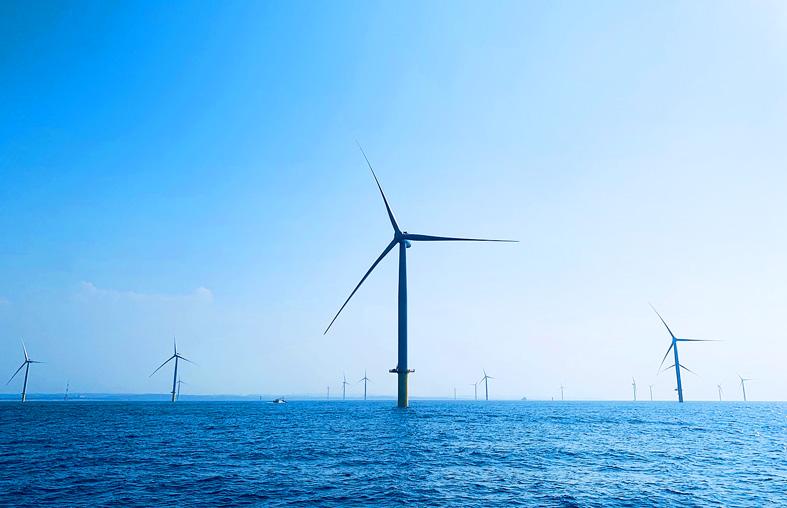Taiya Renewable Energy Co (台亞風能) has thrown its hat into the ring for the third phase of Taiwan’s offshore wind farm development with two projects totaling 2.1 gigawatts (GW) in capacity, the company said yesterday as it applied for an environmental impact assessment (EIA).
One of the projects, called HuanYu (環宇), with a capacity of 627 megawatts, would be off the coast of Taichung, the firm said.
It would use fixed-bottom turbines and would be submitted to next year’s auction, it added.

Photo: Lin Jing-hua, Taipei Times
The other project, called HuanYa (環亞), with 1.43GW capacity, would be farther off Miaoli County and might enter a later auction, the company said.
It would be the first floating offshore wind farm proposal in Taiwan, it said.
“We are still hoping to prepare the HuanYa project in time for the auction next year, but the schedule is really tight,” the company said.
The company’s team comprises talent from other companies that participated in Taiwan’s previous phases of offshore wind farm development, including CSBC-DEME Wind Engineering Co (CDWE, 台船環海), Siemens Gamesa Renewable Energy SA, Swancor Renewable Energy Co (上緯新能源) and Germany’s Wpd AG.
The second phase of the nation’s offshore wind farm development was dominated by European players.
However, more local players are likely to join the competition in the third phase, the Bureau of Energy has said.
According to the government’s project selection process for the third phase, developers first need to prove that they have the technical and financial wherewithal to complete the project, while an EIA report would be required to enter the selection process.
A potential candidate has to show that it can comply with a local content requirement, and the projects that pass the selection process would compete on price in a winner-takes-all auction, the bureau said.

TAKING STOCK: A Taiwanese cookware firm in Vietnam urged customers to assess inventory or place orders early so shipments can reach the US while tariffs are paused Taiwanese businesses in Vietnam are exploring alternatives after the White House imposed a 46 percent import duty on Vietnamese goods, following US President Donald Trump’s announcement of “reciprocal” tariffs on the US’ trading partners. Lo Shih-liang (羅世良), chairman of Brico Industry Co (裕茂工業), a Taiwanese company that manufactures cast iron cookware and stove components in Vietnam, said that more than 40 percent of his business was tied to the US market, describing the constant US policy shifts as an emotional roller coaster. “I work during the day and stay up all night watching the news. I’ve been following US news until 3am

UNCERTAINTY: Innolux activated a stringent supply chain management mechanism, as it did during the COVID-19 pandemic, to ensure optimal inventory levels for customers Flat-panel display makers AUO Corp (友達) and Innolux Corp (群創) yesterday said that about 12 to 20 percent of their display business is at risk of potential US tariffs and that they would relocate production or shipment destinations to mitigate the levies’ effects. US tariffs would have a direct impact of US$200 million on AUO’s revenue, company chairman Paul Peng (彭雙浪) told reporters on the sidelines of the Touch Taiwan trade show in Taipei yesterday. That would make up about 12 percent of the company’s overall revenue. To cope with the tariff uncertainty, AUO plans to allocate its production to manufacturing facilities in

COLLABORATION: Given Taiwan’s key position in global supply chains, the US firm is discussing strategies with local partners and clients to deal with global uncertainties Advanced Micro Devices Inc (AMD) yesterday said it is meeting with local ecosystem partners, including Taiwan Semiconductor Manufacturing Co (TSMC, 台積電), to discuss strategies, including long-term manufacturing, to navigate uncertainties such as US tariffs, as Taiwan occupies an important position in global supply chains. AMD chief executive officer Lisa Su (蘇姿丰) told reporters that Taiwan is an important part of the chip designer’s ecosystem and she is discussing with partners and customers in Taiwan to forge strong collaborations on different areas during this critical period. AMD has just become the first artificial-intelligence (AI) server chip customer of TSMC to utilize its advanced

Six years ago, LVMH’s billionaire CEO Bernard Arnault and US President Donald Trump cut the blue ribbon on a factory in rural Texas that would make designer handbags for Louis Vuitton, one of the world’s best-known luxury brands. However, since the high-profile opening, the factory has faced a host of problems limiting production, 11 former Louis Vuitton employees said. The site has consistently ranked among the worst-performing for Louis Vuitton globally, “significantly” underperforming other facilities, said three former Louis Vuitton workers and a senior industry source, who cited internal rankings shared with staff. The plant’s problems — which have not